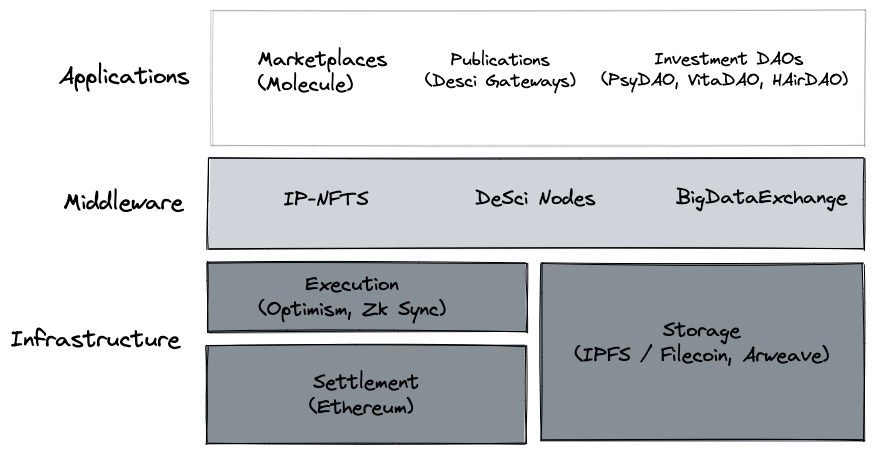by Patrick Mayr
Over the past few months we’ve seen the emergence of the decentralised science (DeSci) stack. For simplicity’s sake, I’ve broken it down into 3 core layers - infrastructure, middleware and applications.

Infrastructure. Putting scientific research on-chain, not just online, enables anyone to access it. Most of DeSci is currently built on Ethereum but can just as well be built on other smart contract platforms. As smart contracts can only store a limited amount of data, storage networks like IPFS and Arweave are used to store larger data loads. Scaling technologies such as optimistic and ZK rollups enable faster and cheaper compute that opens up a surface area of applications previously not possible. For example, posting scientific research and data on-chain becomes much more feasible when transaction costs are a matter of cents rather than hundreds of dollars. Privacy related technology, including ZK, is generally important in the sciences when dealing with patient information and other sensitive data.
Middleware. Middleware serves as a catalyst for innovation on the application layer because it adds a layer of abstraction on top of generalised infrastructure that makes it easier for developers to build applications. IP-NFTs, DeSci Nodes and BigDataExchange are some examples. IP-NFTs are NFTs that contain scientific IP. They are built on the ERC-721 standard and store metadata on Arweave. If developers want to integrate IP-NFTs into their application, they can simply interface with the IP-NFT standard instead of having to rebuild underlying infrastructure. Desci Nodes are an open repository of scientific research on IPFS. IPFS is a generalised and decentralised database that remains difficult to use. DeSci Nodes provide a layer of abstraction on top of IPFS that streamlines the access and publishing flows of scientists. BigDataExchange is a horizontal auction house for storage deals on Filecoin that abstracts some of underlying mechanics of Filecoin by facilitating cheaper storage for higher-level apps.
Applications. A lot of the activity on the application layer has so far focused on financing. Investment DAOs like VitaDAO, HairDAO, PsyDAO, AthenaDAO etc. attract values-aligned communities that then invest in related scientific research, and provide researchers with an additional avenue for funding. Marketplaces such as Molecule enable IP to be transacted between buyers and sellers via IP-NFTs. As more infrastructure comes online, we expect new types of applications to emerge. In some cases teams take on a dual role of building both applications and infrastructure. The Molecule team is building a marketplace for early stage bio IP and has also developed the IP-NFT standard to facilitate interoperability across the industry for IP holding. That standard is used by the Molecule team but can also be used by third party developers. Desci Labs is building both DeSci Nodes and gateways for people to access stored research in an easy way. In emerging categories, teams building applications are often in the best position to recognize what infrastructure is missing to then build it themselves out of necessity.
USV previously wrote a post on how advancements in applications and infrastructure are reinforcing—as more applications emerge, more infrastructure is built to support these applications, which in turn catalyses more applications. I think we’re seeing the same pattern play out in DeSci and am excited to see it develop.